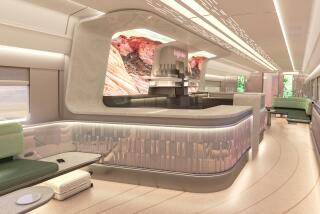CalTrain Gets Modern 2-Decker Cars
- Share via
SAN FRANCISCO — The first of 63 new two-level steel passenger cars for CalTrain, California’s popular commuter service between San Jose and San Francisco, are coming off the assembly line in a waterfront warehouse at Pier 50.
The coaches, costing $56 million, and 18 new diesel engines costing $24 million, financed by federal, state and county money, will be phased in gradually, with all equipment expected to be on the line by next February.
CalTrain is not Amtrak.
It is a railroad system run by the California Department of Transportation under a 10-year contract with Southern Pacific Transportation Co. that became effective July 10, 1980. Southern Pacific operates the trains on its tracks for Caltrans.
Commuter trains have run on the same route for 121 years.
About 18,000 passengers ride 23 round trips a day, totaling more than 5 million riders last year. The fare-to-cost ratio is only 36%, with operating costs last year running $22 million and revenue only $8.1 million. The system serves 28 communities.
“We’re expecting an upsurge in ridership once we get the new equipment phased in,” said Fred Barton, chief of rail operations for Caltrans. “The new equipment is much more efficient, less labor intensive. It will lower our annual deficit.”
Faster turnaround time will be possible as the new locomotives pull the trains in one direction, push them in the other direction.
The first 27 of the 85-foot-long cars--each capable of carrying 139 passengers--will replace coaches in operation since 1924. Other equipment to be replaced was built in the 1950s. The shells of the 63 new all-steel cars are being manufactured by Nippon Sharyo in Toyokawa City, Japan.
Each car is being outfitted with lighting, communications, heaters, carpeting and seats at Pier 50.
The 18 diesel engines are being manufactured by General Motors Corp. in La Grange, Ill.
More to Read
Sign up for Essential California
The most important California stories and recommendations in your inbox every morning.
You may occasionally receive promotional content from the Los Angeles Times.










